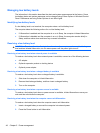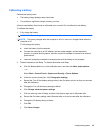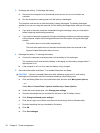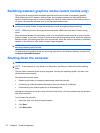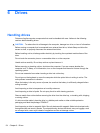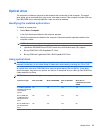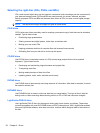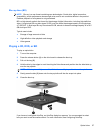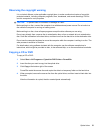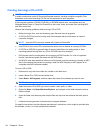
Selecting the right disc (CDs, DVDs, and BDs)
CDs, used to store digital data, are also used for commercial audio recordings and are convenient for
your personal storage needs. DVDs and BDs are used primarily for movies, software, and data
backup purposes. DVDs and BDs are the same form factor as CDs, but have a much higher storage
capacity.
NOTE: The optical drive might not support all types of optical discs.
CD-R discs
CD-R (write-once) discs are widely used for creating a permanent copy of data that can be shared as
needed. Typical uses include:
● Distributing large presentations
● Sharing scanned and digital photos, video clips, and written data
● Making your own music CDs
●
Keeping permanent archives of computer files and scanned home records
●
Offloading files from your hard drive to free up disk space
CD-RW discs
Use CD-RW discs (a rewritable version of a CD) to store large projects that must be updated
frequently. Typical uses include:
● Developing and maintaining large documents and project files
● Transporting work files
● Making weekly backups of hard drive files
● Updating photos, video, audio, and data continuously
DVD±R discs
Use DVD±R discs to permanently store large amounts of information. After data is recorded, it cannot
be erased or written over.
DVD±RW discs
Use DVD±RW discs to erase or write over data that you saved earlier. This type of disc is ideal for
testing audio or video recordings before burning them to a CD or DVD that cannot be changed.
LightScribe DVD+R discs
Use LightScribe DVD+R discs for sharing and storing data, home videos, and photos. These discs
are read-compatible with most DVD-ROM drives and DVD video players. With a LightScribe-enabled
drive and LightScribe software, write data to the disc, and then add a designer label to the outside of
the disc.
56 Chapter 6 Drives



